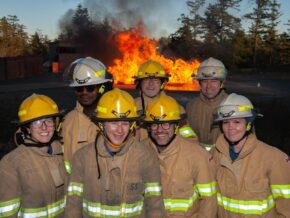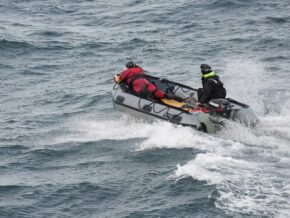
TEAMWORK AND LEADERSHIP
(and other lessons at sea from the Royal Canadian Navy)
The Royal Canadian Navy (RCN) invited a select group of Canadian leaders in government, business & academia to be part of an outreach program called “Canadian Leaders at Sea” (CLaS).
Robin Kerbel, CEO and Co-Founder of Six Degrees Medical (SDM) was one of the invitees and reveals what happened on the 3 days of action-packed and physically demanding demonstrations of RCN operations.

The CLaS program is designed to give leaders an appreciation for the level of professional excellence that is required to conduct naval operations on behalf of Canada. Through the program, participants learn of the exceptional capabilities of the Royal Canadian Navy and its role in defending our country. They become familiar with such features as the main armament, .50 caliber heavy machine gun firings, damage control, battle procedure demonstrations and replenishment at sea. They also gain insights into navigation, and seamanship as well as receive weapons and mechanical briefings, tours of the ship, and hands-on participation in many exercises and drills. Most important, at the core of the program, they are exposed first hand to the importance of leadership and teamwork, as essential at sea as it is in any work environment.
Our CEO, Robin Kerbel, was one of the leaders invited in NOVEMBER 2019. Here she talks about the program, its activities and offers some business insights.
So Robin, tell me about CLaS? Is it really like an official navy training session?
Robin: For a civilian, that’s definitely how it felt. We participated in such n exercises as target practice firing at an oncoming watercraft, and a fire evacuation which was much harder than I would have expected. And even simple things like walking around the ship and showering require a lot of balance as well as physical strength.
We were truly integrated into daily life aboard including sharing meals with the crew, learning about their lives and the life at sea, observing them in action and exchanging tips and information.
I found the experience to be both challenging and rewarding, and it gave me a newfound appreciation for what our Navy does to defend Canada’s interests and values.
Were there any similarities between life at sea and corporate life?
R: At all times, we were constantly working to find and keep our balance in the face of rough waters and instability. Isn’t that what business leaders are faced with on a regular basis? And the importance of teamwork was evident in every exercise.
Just as we have SOPs in our business, the RCN has well-articulated and practiced procedures and protocols that everyone on board must know inside and out. Each person knew their role and understood how they contributed to the task at hand. And many of the sailors are cross-trained so that in case of emergency anyone can jump in and support their teammates. I saw a lot of parallels between this approach and how we work as a team.
Did the RCN’s approach to leadership resonate with yours?
R: What struck me were the similarities between being a leader in my business and the leadership challenges faced by the captain. In conversations on-board, I was surprised that just as I have evolved my leadership style over the past few years so has the captain. The hierarchical approach to leadership that I had assumed was still in play in the military is no longer acceptable by today’s workforce and that is just as true for those of us in the private sector.








